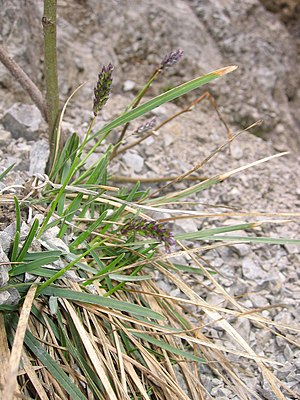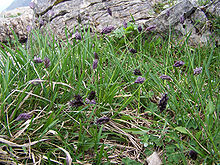Blue grass
| Blue grass | ||||||||||||
|---|---|---|---|---|---|---|---|---|---|---|---|---|

Lime blue grass ( Sesleria caerulea ) |
||||||||||||
| Systematics | ||||||||||||
|
||||||||||||
| Scientific name | ||||||||||||
| Sesleria | ||||||||||||
| Scop. |
The blue grasses ( Sesleria ) are a genus of plants in the sweet grass family (Poaceae). The approximately 27 species are mainly found in Europe.
description


Vegetative characteristics
The blue grass species are clump or lawn-forming, perennial herbaceous plants . They form numerous non-flowering shoots that grow up within the lowest leaf sheaths (intravaginally). The independently upright stalks are unbranched.
The alternate leaves are arranged in a petiole and a leaf blade. The leaf sheaths are closed to the top, the lowest often remain long. The ligule is a membranous border of up to 1 millimeter in length, which is ciliate on the upper edge. The leaf blades are expanded or folded, and stiff.
Generative characteristics
The spike-like inflorescences are rounded-ovate to cylindrical and tightly drawn together, of slate-gray, bluish or whitish color. The side branches at the base have no or two large, rounded-egg-shaped or scale-shaped bracts . The spikelets contain two to five flowers and are laterally compressed. All flowers are hermaphroditic and fall individually from the glumes at maturity . These are almost identical, have one, rarely up to three nerves, are shorter than the spikelet, usually awn-tipped, keeled and thin-skinned. The lemmas are five (rarely up to seven) annoying, have one, three or five awning tips, are keeled, membranous and have hair on the edge and the nerves. The palea are thin-skinned and about the same length as the palea. The ovary is usually hairy on the upper side. It has two styluses that are fused in the lower area. The stigmas are thread-like and protrude at the tip of the floret.
The caryopses are ellipsoidal and hairy at the top. The embryo is a quarter to a third as long as the fruit. The navel is round and the same length as the embryo.
Systematics and distribution
The genus Sesleria was founded in 1760 by Giovanni Antonio Scopoli. set up. The generic name Sesleria honors the Italian doctor and botanist Lionardo Sesler († 1785).
The genus Sesleria belongs to the tribe Poeae in the subfamily Pooideae within the family Poaceae .
The genus Sesleria includes around 26 species, depending on the author. This applies in the event that the Sesleriella and Psilathera , which are sometimes viewed as separate genera, are included. The nomenclature is not the same in different floristic works. The same name is sometimes used for different species.



Most Sesleria species are restricted to Europe, one also occurs in Africa and five in Asia. The main focus of the species is the Balkan Peninsula. The genus Sesleria with a global distribution focus in the Illyrian-Balkan flora region, in Central Europe there are lime blue grass ( Sesleria caerulea (L.) Ard. ), Bog blue grass ( Sesleria uliginosa ), dwarf blue grass or egg-shaped blue grass ( Sesleria ovata (Hoppe ) A. Kern. ), Hungarian blue grass or Pannonia blue grass or Pannonian blue grass ( Sesleria sadleriana Janka ) and spherical blue grass ( Sesleria sphaerocephala Ard. ).
There are 26 to 28 types (as of 2016):
- Sesleria Achtarovii Deyl (Syn .: Sesleria rigida subsp. Achtarovii (Deyl) Deyl ): It occurs only in southeastern Bulgaria and in north-central to northeastern Greece and on islands in the northern Aegean .
- Sesleria alba Sm. (Syn .: Sesleria anatolica Deyl , Sesleria anatolica var. Peyronii Deyl , Sesleria anatolica var. Rossica Deyl , Sesleria anatolica var. Voronovii Deyl , Sesleria autumnalis subsp. Anatolica (Deyl) Tzvelev , Sesleria autumnalis var. Voronovii (Deyl ) Tzvelev , Sesleria alba subsp. Voronovii (Deyl) Tzvelev , Sesleria pontica Deyl ): It occurs from Bulgaria through northern to northeastern Greece, on islands of the Aegean to Lebanon , on the Crimea and in the Caucasus . The extent of this species is controversial.
- Sesleria araratica Kit Tan : It occurs from Turkey to Transcaucasia .
- Silver blue grass ( Sesleria argentea (Savi) Savi ): It occurs in Spain , France and Italy .
- Autumn blue grass ( Sesleria autumnalis (Scop.) FWSchultz ): It occurs in Italy, Slovenia , Croatia , Bosnia , Montenegro as well as Albania and in northern Greece.
- Sesleria bielzii Schur : It occurs from Southeastern Europe to Ukraine .
- Lime blue grass ( Sesleria caerulea (L.) Ard. , Syn .: Sesleria albicans Kit. Ex Schult. And Sesleria varia (Jacq.) Wettst. ): It is in Western and Central Europe, also Iceland , Poland , the Czech Republic , Slovakia , Hungary , Slovenia, northern Italy, France and Spain.
- Sesleria calabrica (Deyl) Di Pietro : This endemic occurs only in southern Italy.
- Sesleria coerulans Friv. : It occurs from south-east Europe, north-central to north-east Greece to Ukraine.
- Sesleria comosa Velen. : It occurs only on the western to northern Balkan peninsula.
- Sesleria doerfleri Hayek : This endemic occurs only in Crete . This species belongs to the Sesleria robusta complex.
- Sesleria filifolia Hoppe : Home is Serbia, Bulgaria and Romania.
- Green head grass ( Sesleria heufleriana Schur ): It occurs in Slovakia, Hungary, Romania and western Russia .
- Sesleria insularis Sommier : It occurs in Italy, Sardinia , Corsica , the Balearic Islands and the Balkan Peninsula.
- Sesleria juncifolia Suffren (Syn .: Sesleria tenuifolia Schrad. ): It occurs in the amphi-Adriatic, central Apennines , western Balkans to southern Albania.
- Sesleria korabensis (Kümmerle & Jáv.) Deyl : The home is the Balkan Peninsula.
- Sesleria latifolia (Adamović) sword : It occurs only on the eastern Balkan peninsula (in eastern Serbia and western Bulgaria) and on the Peloponnese .
- Sesleria nitida Ten. : It only thrives in the mountains of Italy and Sicily .
- Dwarf blue grass or egg-shaped blue grass ( Sesleria ovata (Hoppe) A.Kern. ): It only thrives in the Alps from Italy, France, Germany , Austria to Slovenia.
- Sesleria phleoides Steven ex Roem. & Schult. : It occurs from Turkey to Iran.
- Sesleria pichiana Foggi, Rossi & Pignotti : This endemic occurs in Italy only in Emilia-Romagna .
- Sesleria rhodopaea Tashev & Dimitrov : This endemic thrives only in the central Rhodope Mountains in Bulgaria. It isclosely relatedto Sesleria latifolia .
- Sesleria rigida Heuff. ex Rchb. : It only thrives in the mountains of the Balkan Peninsula, Romania.
- Sesleria robusta Schott, Nyman & Kotschy : It only thrives in the maritime to subcontinental Dinarides between Biokovo and Rumija planina in Croatia, Bosnia and Herzegovina and Montenegro and on mainland Greece and the Peloponnese.
- Hungarian blue grass or Pannonia blue grass or Pannonian blue grass ( Sesleria sadleriana Janka ): It occurs in Austria, Slovenia, Hungary and Poland.
- Sesleria serbica (Adamovic) Ujhelyi : It occurs only in eastern Bosnia and western Serbia .
- Sesleria taygetea Hayek : This endemic occurs only in southern Greece to the Peloponnese.
- Sesleria tenerrima (Fritsch) Hayek : It occurs on the Balkan Peninsula up to mainland Greece and on islands in the western Aegean.
- Bog blue grass ( Sesleria uliginosa Opiz ; due to an incorrect lectotyping of the first description by Linné, this species was sometimes incorrectly called Sesleria caerulea .): It occurs in Sweden , Finland , Poland , the Czech Republic, Austria, Northern Italy, Hungary, Montenegro, Romania, Bulgaria and Western Russia before; it is missing in Germany.
- Sesleria vaginalis Boiss. & Orph. : It occurs on the eastern Greek mainland, on the Peloponnese and on islands of the western Aegean.
- Sesleria wettsteinii Dörfl. & Hayek : It only occurs in the Prokletije massif and the Paštrik .
Some authors no longer include the genus Sesleria (as of 2006):
- Sesleria disticha (Wulfen) Pers. → Oreochloa disticha (Wulfen) Link
- Sesleria leucocephala DC. → Sesleriella leucocephala (DC.) Deyl, on the other hand, at GrassBase it is still Sesleria leucocephala .
- Globular blue grass ( Sesleria sphaerocephala Ard. ): This endemic thrives only in the south-eastern Alps in Switzerland , Austria, Italy and Slovenia. → Sesleriella sphaerocephala (Ard.) Deyl
literature
- Siegmund Seybold (Ed.): Schmeil-Fitschen interactive . CD-ROM, version 1.1. Quelle & Meyer, Wiebelsheim 2002, ISBN 3-494-01327-6 .
- Miloš Deyl : Study of the genus Sesleria , Československá Botanická Společnost Praha. Office: Praha XIX, Zahradní 44, Czechoslovakia, 1946. scanned.
- Hans Joachim Conert: Sesleria. In: Hans Joachim Conert (ed.): Illustrated flora of Central Europe . Founded by Gustav Hegi. 3rd, completely revised edition. Volume I. Part 3: Spermatophyta: Angiospermae: Monocotyledones 1 (2). Poaceae (real grasses or sweet grasses) . Parey Buchverlag, Berlin 1998, ISBN 3-8263-2868-X , p. 473–486 (published in deliveries 1979–1998, 6th and 7th deliveries, 1992 and 1994).
Individual evidence
- ↑ a b c d e Manfred A. Fischer, Karl Oswald, Wolfgang Adler: Excursions flora for Austria, Liechtenstein and South Tyrol . 3rd, improved edition. Province of Upper Austria, Biology Center of the Upper Austrian State Museums, Linz 2008, ISBN 978-3-85474-187-9 , p. 1173-1174 .
- ↑ a b The genus Sesleria . In: WD Clayton, MS Vorontsova, KT Harman, H. Williamson: GrassBase - The Online World Grass Flora. As of February 3, 2016, last accessed on June 27, 2020.
- ↑ Meusel, Jäger Schubert 1978: Chorology of the Central European Flora , Volume I, p. 406 Sesleria - PDF.
- ^ Siegmund Seybold (Ed.): Schmeil-Fitschen interactive . CD-ROM, version 1.1. Quelle & Meyer, Wiebelsheim 2002, ISBN 3-494-01327-6 .
- ↑ a b Sesleria caerulea in The Euro + Med PlantBase - the information resource for Euro-Mediterranean plant diversity , accessed on January 9, 2015
- ↑ a b Sesleria uliginosa in The Euro + Med PlantBase - the information resource for Euro-Mediterranean plant diversity, accessed on January 9, 2015
- ^ A b Sesleria species list from WD Clayton, MS Vorontsova, K. T Harman, H. Williamson: GrassBase - The Online World Grass Flora. As of February 3, 2016 , last accessed on June 27, 2020.
- ↑ a b c d e f g h i j k l m n o p q r s t u v w x WD Clayton, KT Harman, H. Williamson, 2006: World Grass Species - Synonymy database. The Board of Trustees of the Royal Botanic Gardens, Kew. Rafaël Govaerts (Ed.): Sesleria. In: World Checklist of Selected Plant Families (WCSP) - The Board of Trustees of the Royal Botanic Gardens, Kew . Retrieved June 26, 2020.
- ↑ N. Kuzmanovic et al .: Genetic, cytological and morphological differentiation within the Balkan-Carpathian Sesleria rigida sensu Fl. Eur. (Poaceae): A taxonomically intricate tetraploid-octoploid complex. In: Taxon , Volume 62, 2013, p. 458-472.
- ↑ a b c d e f g h i j k data sheet from P. Dimopoulos, T. Raus, E. Bergmeier, T. Constantinidis, G. Iatrou, S. Kokkini, A. Strid, D. Tzanoudakis, 2013: Flora of Greece Web - Vascular plants of Greece: An annotated checklist with distribution maps of the species found in Greece.
- ↑ a b c d e f Walter Erhardt , Erich Götz, Nils Bödeker, Siegmund Seybold: The great pikeperch. Encyclopedia of Plant Names. Volume 2: Types and Varieties. Eugen Ulmer, Stuttgart (Hohenheim) 2008, ISBN 978-3-8001-5406-7 , p. 1742.
- ↑ a b c d e Romeo di Pietro, Nevena Kuzmanović, Duilio Iamonico, Dmitar Lakušić: Nomenclatural and taxonomic notes on Sesleria sect. Argenteae (Poaceae). In: Phytotaxa , Volume 309, Issue 2, 2017, pp. 101–117.
- ^ Romeo di Pietro, Robert P. Wagensommer: A new Sesleria juncifolia association from south-eastern Italy and its position in the amphi-adriatic context. In: Acta Botanica Croatia , Volume 73, Issue 1, 2014, pp. 171-207. doi : 10.2478 / botcro-2013-0018 PDF.

